Major Nichols
Posted: Sunday 07th June 2020
Major Nichols bicycles were made in West Bromwich and later in Smethwick between 1947 and 2005 when, after a short illness, Major Nichols died. This indefatigable frame builder had kept his shop open until about 2003 after ill health and social unrest forced an almost permanent closure except to old customers.
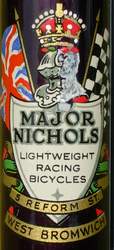
The bicycles were well known in the West Midlands region and wider circles in the 1960’s, ‘70’s and ‘80’s. These sporting lightweight frames were the choice of local, and not so local, cycle cognoscenti, whether it was for pure racing on track or road, or for touring.
Major Nichols had developed his cycle business on returning from service in the Navy in the Second World War. His father had run his own bicycle business from the same premises but died in 1947 so his electrical engineer son had some rapid learning to do. At first Major’s business depended on buying in lower priced mass produced bicycles from Centric Cycles, a regional trade supplier of a range of bicycles, some of a lightweight quality – others not so light! These cheaper end bikes were Major’s bread and butter income as he built up his own skills and ultimately a specialist bike trade with true sports and racing machines.
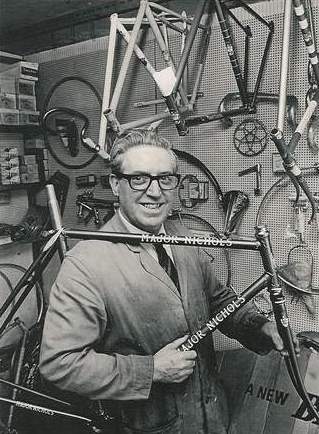
Major had initially known very little about frame building but with advice from Centric’s chief frame builder taught himself frame building skills. His hand-made frames were always been “of a sporting characteristic” and became true custom quality items. He never attempted to make cheaper frames himself and latterly the shop was an agent for Viking, Dawes and some other local major lightweight suppliers.
Major was very aware of the importance of the appearance of his bikes for advertising his marque. The paint shop was always on the premises as the finish of the bike was very important to Major. As with everything he did, Major‘s finishes were exemplary and he was justifiably proud of his work. To see any Major Nichols in its original finish of high gloss colour and superbly styled transfers, is to realize the machine was styled by someone who had that essential flair that turns a well crafted item or design into high art, a beauty to behold. The 1960’s frames were nearly all brightly coloured often with the transfers on contrasting colour bands. Competition bikes made in the 1960’s might well have the Major Nichols logo on both sides of the top tube and the down tube, even the chain stays, and additionally they might have the vertically aligned capitals Major Nichols or just Nichols down both sides of the seat tube and each arm of the front forks.
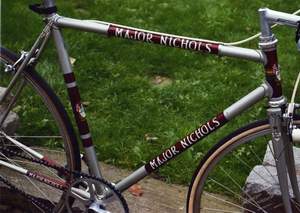
In later years the frame colours tended to be rather more subtle but one idiosyncratic feature at this time was the very effective use of colour lining where very often the three main lug-lining areas (head, bottom bracket and seat pin lugs) were picked out using separate colours, such as red, white or blue.
Major Nichols frames were always built in Reynolds 531 with plain gauge for stock frames which would have suitable for sports bicycle buyers. In the early 1950 and 60’s most Major Nichols frames were built with Nervex Pro lugs. By the mid sixties the plainer Prugnat lugs were in use, following a general trend in fashion in the cycle world. Stock frames in the early years used the relatively expensive 531 tubing only for the three main tubes of the frame, with the seat and chain stay being cheaper, unclassified Reynolds plain gauge tubing.
It appears that early frames may have been built with various styles to the top of the seat stays such as chamfered, fluted or sloping, and certainly the earliest known frames, 1954/5 have these simple patterns of seat stay top. In particular in the early days the cheaper stock built frames had simple rounded top seat stays.
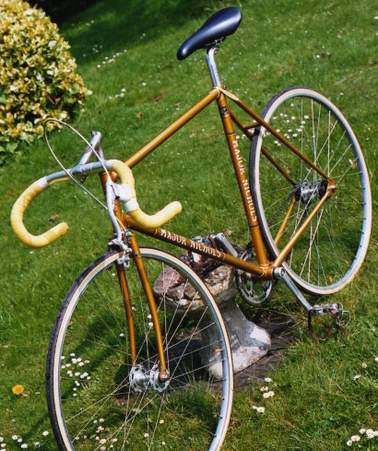
Many later Major Nichols frames, apart from the lugless frames, were more uniformly built with a feature that almost became a Major Nichols trade mark on the later 1970 to 1980’s bikes. This was the wrap-over seat stay tops with a thin strap over the top tube that joined the two stays. The feature was not unique to Major Nichols, but his tops stand out for the elegance. The top of the stays each had a curved panel. Sometimes these were made as a pair with an integral strap or sometimes the tops had the strap brazed into position between the two stays. There was said to be a choice of the size of the flat oval panel formed at the top of the stays, so that short, medium or long oval panels could be built into the wrap-over.
Later on the lighter and more expensive double butted Reynolds 531DB was used for all fully custom frames including the racing frames, with a few frames made from 531 Special (later known as 531c tubing) and, later again, in the very special Reynolds 753 tubing. More expensive racing frames had two additional small triangular transfers ‘Record Road Sprint’ which were fixed on the front forks No special names were ever formally given by Major to specific styles of his bikes but Roger Allen remembers that he and his club-mates in West Bromwich CTC always referred to their custom and specially lightweight Major Nichols as Records. They could of course be recognised by having the ‘Record Road Sprint’ transfers on the front forks.
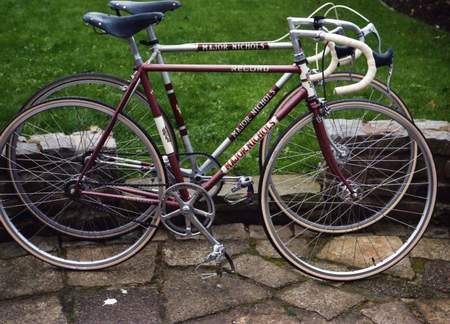
Currently only about 60 bikes are known to survive, with some details of a further 10 or so remembered, though there would have been very many more built. News of more of them is avidly awaited. Major’s frames carry the frame number on the bottom bracket. There is a prefix MN followed by, or below which was, a four or five digit production number, consisting of the year as the first two digits then that year’s bike production number in annual sequence. Usually the forks carried only the current year’s production number.
David Clement has told us that he worked for Major Nichols from 1958 to 1965. At first, he used to work there every day after school and all day Saturday, then later on after Major was badly burned in an accident he went to work for him full time. He used to do all the spraying, build the stock bikes, wheel building and most of the repairs. Asked about Wilsons of Birmingham frames, he thought Major started to build Wilson frames after Gameson retired. In the early sixties Major built frames for numerous shops.
I didn’t know Major terribly well, but I do remember him. He was a ‘one off’, once met never forgotten. I remember that he was particularly contemptuous of the American cycle trade. He once showed me a sheaf of orders from various traders in the US, saying that they did not understand how frames should be built, and that if he built to their specifications then the bikes would be unrideable. He then tore the orders into shreds and binned them! He was even more contemptuous of the ‘Lambert of London’ factory, set up a couple of miles away in Bilston by an American company. When Lambert actually went into production, the bikes they made were, indeed, unrideable due to their steering geometry.
I recall on one occasion taking my mate, Denis,to Reform Street to order a frame . Den wanted a pure racing frame, with close clearances and no mudguard eyes. Major’s reponse to the last item was ‘Don’t be bloody daft, do you think it’s never going to bloody well rain?’. The frame duly arrived, with mudguard eyes, finished (as requested) in shocking pink, it looked stunning. My girlfriend found a ‘Pink Panther’ decal, which Den mounted on the seat tube. When Major saw the panther he was delighted.
If Major could be irrascible, then ‘Mrs Major’ as she was quite often known, could be equally fierce. I’d gone to Reform Street after work to buy some bits and pieces. There were two or three clubmen in the shop, chatting in the usual bike rider fashion. At about 6.15pm, Mrs Major appeared through the back door of the shop and said ‘Major, your dinner’s on the table. You lot, bugger off! We’re closed!’
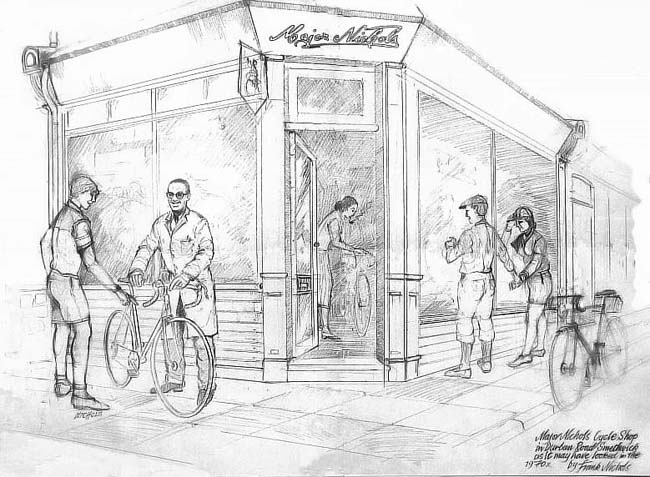
Peter Underwood owns two Major Nichols stock frames. One, from 1968, was actually a cyclo-cross frame, although he used it (and still does) as a touring bike. The other is a standard road frame. Both are built in Reynold 531 tubing with Nervex lugs. Peter had intended to buy a bespoke frame although when he bought the second one Major said ‘You don’t need a special build, have this one off the peg and save yourself a tenner’. Of course, he was right, it fitted Peter like a glove. Peter remembers Tom Crowther, one of the founders of Mercian Cycles in Derby, describing Major’s frames as ‘jewels’. He said that some people might build a frame as good as a ‘Major’, but nobody could build one better. Tom felt that Major’s frames compare favourably with the very finest British builders or anywhere else in the world.
A website dedicated solely to Major Nicholls cycles can also be found here.
Posted: Sunday 07th June 2020
This article appears in the following categories.
Upcoming Events
Whether you are looking for a gentle social meet up, or a 100-mile ride browse the community’s upcoming events and plan your next weekend outing.
